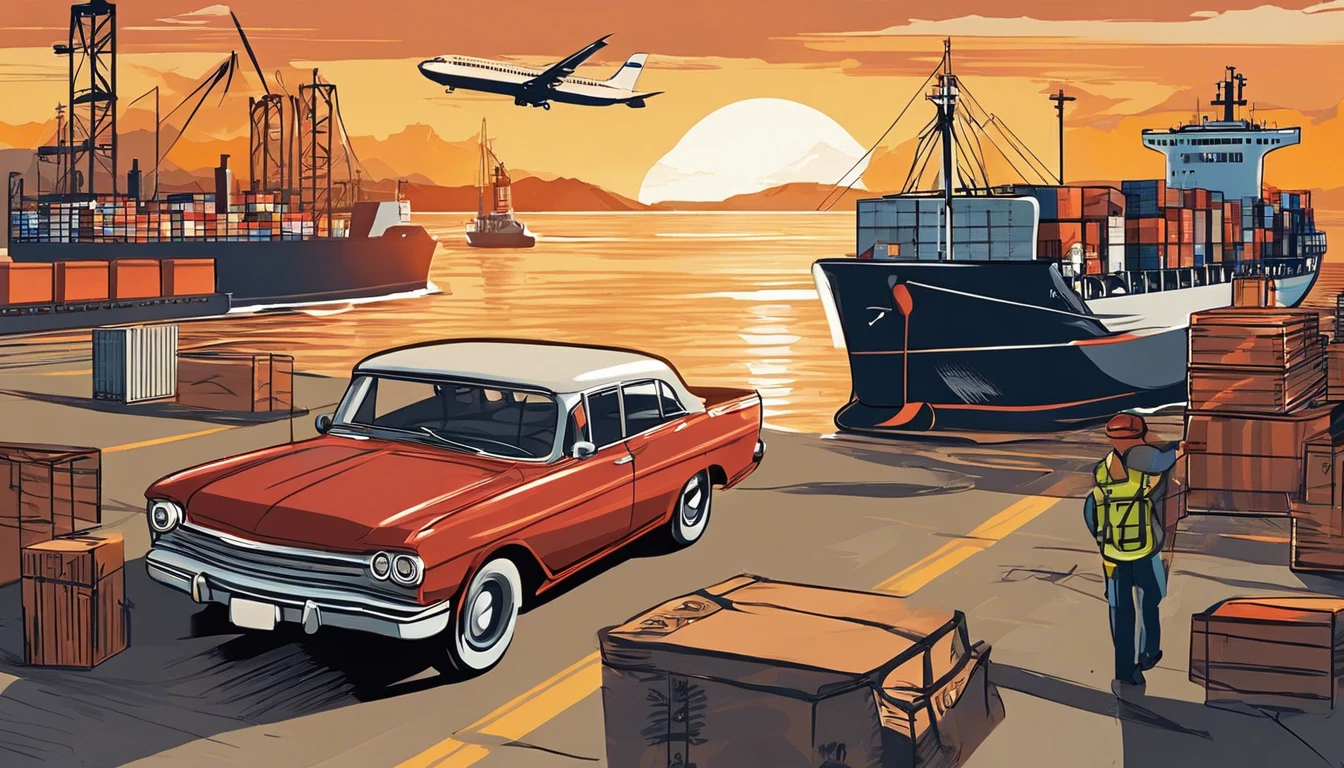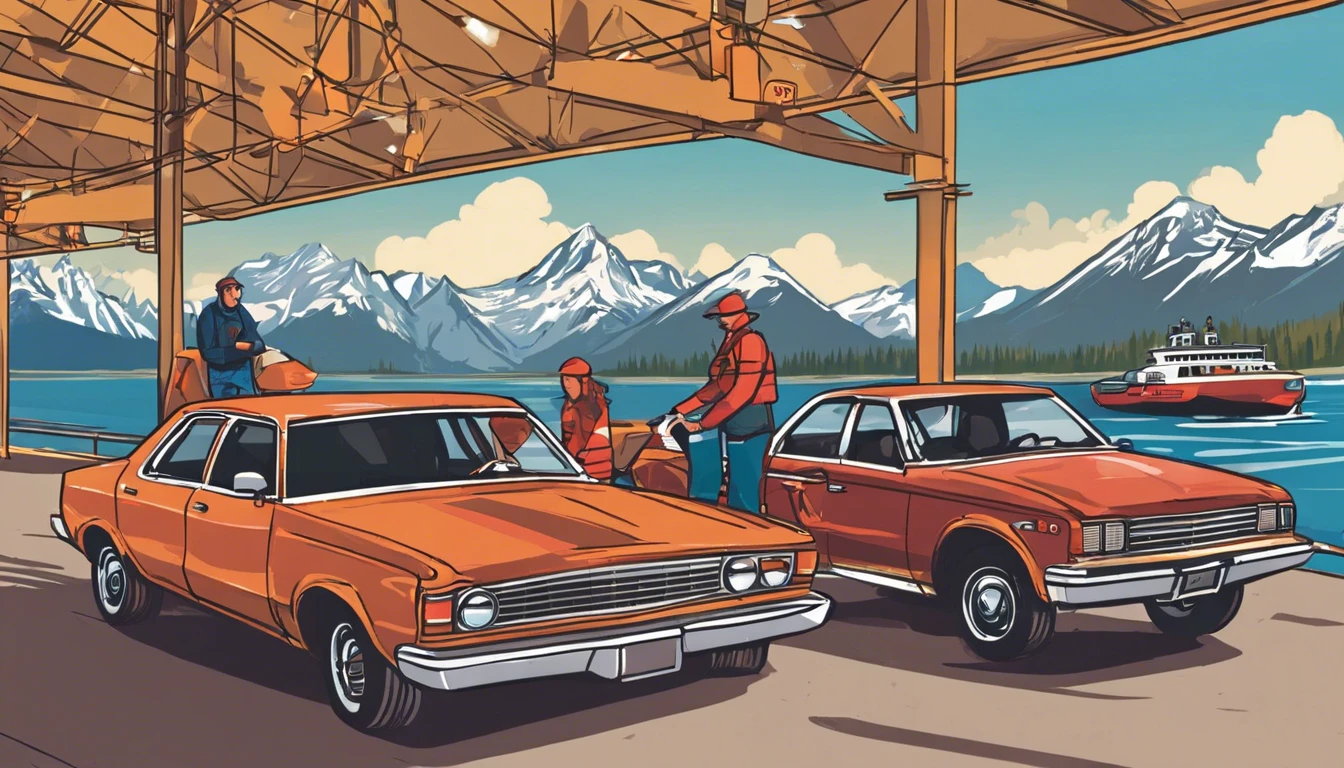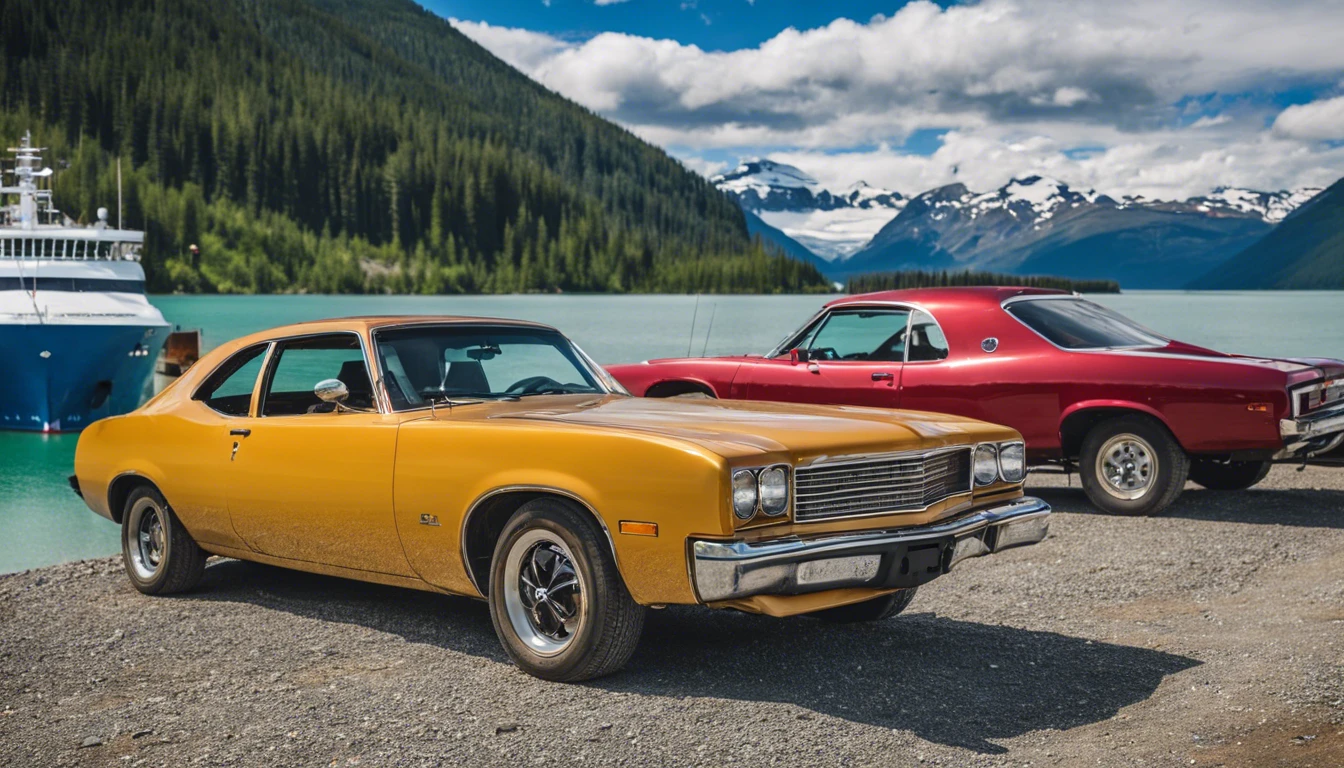How Do I Ship My Car to Alaska Through the Canadian Border?
To ship your car to Alaska through the Canadian border, you can either use open or closed car haulers for overland transport, or consider shipping via sea from ports like Seattle or Tacoma. Preparation of your vehicle, including removing personal items and ensuring a low fuel level, is crucial for safe transit.

Open or Closed Car Haulers
Alright, let's discuss the two main types of car haulers you can choose from when shipping your car to Alaska - open and closed.
Open Car Haulers
Open car haulers are the most common and affordable option. Your car is loaded onto a large, open-air trailer along with several other vehicles, kind of like what a moving company does when transporting new cars to dealerships. While this method is cost-effective, it does have a downside. Your car will be exposed to the elements during the journey, including potential road debris and weather conditions. For instance, if you were moving to Alaska from Oklahoma, the journey would involve driving across the US, Canada, and up the fully paved Alaska Highway. This journey could expose your car to harsh winter conditions, requiring good winter tires and possibly a 4x4 truck if you opted to pull the vehicle yourself or drive the car. However, using an open transport truck is indeed a cost-effective method, although these services primarily operate in summer according to this discussion.
Closed Car Haulers
On the other hand, closed car haulers, also known as enclosed car haulers, offer a higher level of protection. This is what a high-end moving company would use to transport your car inside a fully enclosed trailer, shielding it from potential road damage and weather conditions. This is a great option if your car is a classic, luxury, or otherwise highly valuable vehicle that you want to keep in pristine condition. However, this extra protection comes at a higher cost compared to open car haulers. For example, if you were moving to Alaska and shipping by barge from the Port of Seattle to Anchorage, which takes around five days with pickup approximately seven days post-drop-off, can cost around $2,000 as shared in the same discussion.
In conclusion, if you're moving to Alaska and looking for a more budget-friendly option and your car is relatively sturdy and not overly valuable, an open car hauler could be the way to go. But if your vehicle is particularly valuable or you simply want to ensure it arrives in Alaska in the best condition possible, it may be worth investing in a closed car hauler.
While making this decision, consider your specific circumstances. For instance, some individuals moving to Alaska have found driving vehicles up the AlCan Highway a cost-effective strategy, especially if the destination is accessible by road. This approach allows the transportation of many belongings within the vehicle according to this personal experience. However, remember to prepare for the journey, including bringing bug repellent, having a sturdy hitch and axle for trailers, carrying spare tires due to infrequent service stations, and purchasing a detailed travel guidebook like "The Milepost" as recommended here.
There are also a few other factors to consider when shipping your car. It's important to prepare your vehicle for shipping by removing all personal items, as they will not be covered by the moving company's insurance. It's also a good idea to document your vehicle's condition before shipping, taking photos and noting any existing damage as suggested by Forbes. This way, you'll have evidence in case of any dispute about the condition of your car upon delivery. Additionally, it's wise to check the moving company's reputation and insurance coverage before making a decision.
Shipping from Ports
When it comes to shipping a car to Alaska, there are a few options you can consider. Many shipping companies offer services from the ports of Seattle and Tacoma in Washington state. Your vehicle would then be shipped to either Anchorage or Juneau in Alaska.
The reasons why these ports are popular are pretty straightforward:
-
Accessibility: A lot of Alaska's regions are either only accessible or are much easier to reach by boat. So, shipping your car by sea can often be the most practical choice.
-
Frequency of Service: Due to the high demand, there are regular shipping schedules from Seattle and Tacoma to Anchorage and Juneau. This means you can plan your move and match it with the shipping schedule.
-
Cost: As these are popular routes, you can often find competitive pricing options. Remember, it's always a good idea to get quotes from a few different companies to ensure you're getting the best deal.
One affordable option could be driving your vehicle up the AlCan (Alaska-Canada Highway) if your destination is accessible via the road system. This method not only saves money but also allows you to carry more belongings source.
One thing to keep in mind is that while shipping your car from these ports can be convenient, you'll still need to figure out how to get your vehicle to the port in the first place. This might involve driving it there yourself or arranging for a trucking service to transport it.
Also, don't forget to check with the shipping company about their specific requirements. They might need certain documents or have specific preparations for your car before it can be loaded onto the ship.
Shipping times to Alaska can vary widely. For instance, packages from the East Coast to Anchorage generally take up to 5 days source. This is an important consideration when planning your move as you would want to ensure your car arrives when you need it.
It's worth noting that the Port of Alaska, owned and operated by the Municipality of Anchorage, is the state's primary inbound cargo facility. It handled approximately 4.3 million tons of fuel and cargo in 2019 and serves 90% of Alaska's population. This port is crucial for the delivery of goods and plays a significant role in supporting the state's economy. Its activities support more than $14 billion in commercial activity.
The U.S. transportation system moved an average of 53.6 million tons of freight daily in 2021, valued at over $54 billion. The Freight Analysis Framework predicts an increase in tonnage by about 1.6 percent annually from 2023 to 2050, with the value of freight expected to rise from $1,001 per ton in 2023 to $1,256 per ton in 2050. These figures underline the vitality and scope of the transportation sector, especially for interstate and international shipments source.
In the end, while moving to Alaska can seem daunting, the shipping process can be pretty straightforward if you plan ahead and do your research. The experience of moving to Alaska is highly valued for the unique lifestyle and scenic surroundings it offers.

Vehicle Drop-off and Pick-up Options
When it comes to shipping your car to Alaska through the Canadian border, you have a couple of options to consider - Door-to-Port and Port-to-Port. Let's break down these options to understand them better.
Door-to-Port
This is a convenient option where your car is picked up right from your doorstep and delivered to the port of your choice in Alaska. It's a great choice if you're looking for ease and simplicity, as you won't have to worry about getting your vehicle to the port yourself. However, this convenience comes at a cost. Door-to-Port shipping tends to be more expensive due to the added logistics and the longer distances the shipping company needs to cover.
In some cases, people moving to Alaska from the lower 48 states prefer to drive their vehicles up the Alaska Highway (AlCan) to Alaska. This is a significantly long route but is considered a worthwhile experience. Moreover, packing vehicles with belongings can save a substantial amount of money [source].
Another option for self-moving involves renting a truck, such as a U-Haul. The cost for this option ranges from $3,192 to $6,721 depending on the size of the truck, correlating to the scale of the move, from a small apartment to a family with several bedrooms. The drive from Seattle to Anchorage, approximately 2,260 miles, would require at least $852 in gas for a 15’ U-Haul truck, not factoring in higher gas prices in Canada and Alaska. Overnight stays can add at least $490 to the moving budget, assuming a $70 to $140 per night cost at motels. The total estimated moving cost ranges from $5,192 to $8,692 excluding potential additional expenses such as food and vehicle maintenance [source].
Port-to-Port
If you're looking to save some money and don't mind a bit of extra legwork, Port-to-Port shipping could be your best bet. With this option, you'll need to deliver your vehicle to the shipping company's origin port, and then pick it up from the destination port in Alaska. This means you'll have to arrange transportation for yourself to and from these ports. While it can be a bit more of a hassle, it's typically a cheaper option due to the shorter distances involved.
For those moving household goods, using a service that delivers a trailer to pack and then trucks or barges it to Alaska is an option. It costs about $750 per linear foot, with an 8-week delivery timeframe [source].
Another strategy that some people have used is purchasing a cargo trailer for the move, which can be beneficial due to its resale value upon arrival in Alaska. However, this option requires a suitable truck for transport and consideration of the AlCan's late-spring conditions [source].
In conclusion, the choice between Door-to-Port and Port-to-Port shipping depends on your budget and how much convenience you're looking for. It's all about finding the right balance that suits your needs. Whether you're moving to Anchorage, Juneau, or Fairbanks, or even remote areas like Nome, Dillingham, or Bethel, careful planning is crucial to ensure a smooth and cost-effective transition [source].

Shipping Methods
When it comes to shipping your car to Alaska through the Canadian border, there are two main methods you can choose from: Roll on Roll off (RoRo) and container shipping.
Roll on Roll off (RoRo) Shipping
RoRo is the more common of the two methods and is typically less expensive, especially for shorter ferry trips. As the name suggests, your car is simply driven (or rolled) onto the ship at the point of origin and then driven (or rolled) off at the destination.
- Pros: It's usually cheaper and quicker than the alternative, making it an ideal choice if you're on a budget or short on time. This method can also be part of an overall cost-saving strategy when moving to Alaska. Some people, for instance, opt to drive their vehicles packed with belongings via the AlCan road, a journey that not only allows for significant savings but is also considered a must-do experience at least once in a lifetime according to some accounts. The total cost of moving, including vehicle rental, gas, and overnight accommodations, can range between $5,192 and $8,692, making self-driving a cost-efficient option for some as detailed here.
- Cons: Your car is exposed to the elements during transit, which may not be ideal if you have a classic or high-value car.
Container Shipping
The other option is container shipping. This involves your car being loaded into a secure container and then placed onto the ship.
- Pros: It offers more protection for your car during the journey, which might be preferable if your car is particularly valuable or if you're shipping additional items with it. This method can be particularly useful if you're moving to areas in Alaska not connected by road, such as Nome, Dillingham, or Bethel, where alternative transport methods must be considered. Using this service, which involves packing a trailer that is then trucked or barged up, can take about 8-9 weeks and cost approximately $750 per linear foot with dimensions around 8'x8'. However, the added protection and ability to ship additional items may make it worth the cost for some movers.
- Cons: It's usually more expensive and can take longer than RoRo shipping. However, the cost can be offset by efficient packing to maximize space, as costs are based on space, not weight.
In summary, the best method for you will depend on your specific needs, budget, and the value of your car. It's important to weigh these factors when deciding between RoRo and container shipping. Additionally, the destination in Alaska and the amount of belongings you're transporting can also influence your choice. Whether you're moving to key destinations like Anchorage, Juneau, and Fairbanks, or to more remote locations, both methods have their advantages and can be part of a memorable relocation experience to the unique Alaskan landscapes.

Car Shipping Preparation
Before you set out on your journey, there are a few critical steps you need to take to prepare your car for shipping. These are designed to ensure safety during transit and to comply with shipping regulations.
-
Fuel Level: Your car’s gas tank should be a quarter full or less. This reduces the weight of your vehicle and is a safety measure to minimize the risk of fire during transit.
-
Personal Items: Make sure to remove all personal items from your car. The shipping company is not responsible for personal items left in the vehicle, and these can cause damage during transit. This includes any loose items, documents, and electronics.
-
Car Alarm: It’s important to disable your car alarm before shipping. If it goes off during transit, it can cause unnecessary delays and complications.
-
Vehicle Check: Lastly, ensure your vehicle is in good working order. Check the battery, tires, and other essential components. Any issues should be resolved before shipping to avoid any problems during the process. For those considering driving the AlCan to Alaska, it's recommended to ensure that your vehicle has adequate winter tires, particularly if the move is planned during the colder months 🔗.
Remember, preparing your car for shipping is a crucial part of the process. It not only ensures your vehicle arrives safely but also helps to avoid any potential delays or additional costs.
In addition to preparing your vehicle, you might want to consider other factors such as the time of year and the route you'll be taking. For instance, some people have found it beneficial to turn the move into an adventure, visiting places like Yellowstone and Glacier National Park along the way .
If you're moving to regions in Alaska not accessible by road, such as Nome, Dillingham, or Bethel, you might need to consider other options. One such option is shipping your vehicle from the Port of Seattle to Anchorage by barge. This journey typically takes around five days, with vehicle retrieval approximately seven days post-drop-off in Seattle 🔗.
Another factor to consider is the type of shipping method you choose. For instance, you might opt for over-the-road auto transport, either on an open or enclosed trailer. This method is commonly used for interstate moves within the Lower 48 states. Less common methods include freight train, with specific conditions for practicability, and shipping by plane, reserved for highly expensive or out-of-continental US moves 🔗. The cost of car shipping averages from $550 for open shipping to $2,450 for enclosed shipping. Enclosed car carriers, recommended for valuable vehicles, ensure better protection but accommodate fewer vehicles 🔗.
Lastly, don't forget to prepare yourself for the journey. Bring bug repellent, ensure a sturdy hitch and axle for trailers if you're towing, pack spare tires due to limited tire services, and carry a camera to capture the incredible natural beauty that you'll encounter during your move to Alaska 🔗.





